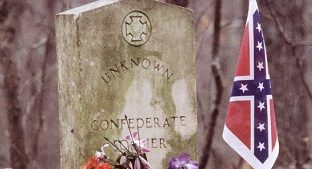Natchez Trace Pathway Through the Past
By David DeVoss
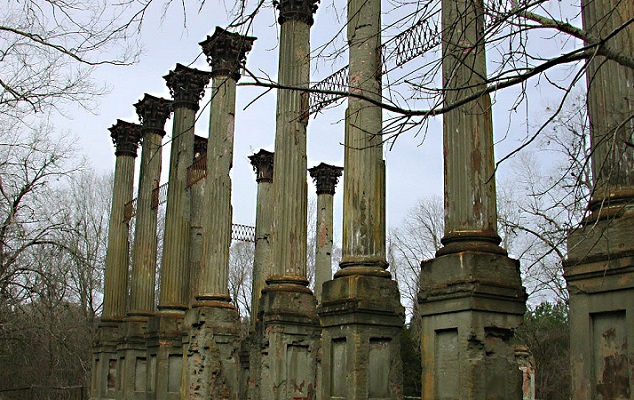
Ruins of Windsor Plantation evoke memories of the antebellum South. Built at a cost of $175,000 by 600 slaves, the ornate plantation served as Yankee headquarters during the war between the states.
It’s midnight on the Mississippi. In the antebellum city of Natchez, high atop a bluff overlooking the river, lights are winking off in the Victorian mansions and plantation homes emblematic of the Old South. Down on the riverbank, inside the Under-the-Hill Saloon, a dozen yahoos fresh off the Delta Queen are chasing Wild Turkeys with Dixie beer and plotting their next move. For proprietor André Farish Jr., the history of Natchez begins in his saloon: “U. S. Grant may have slept up at Rosalie Plantation, but he spent his evenings down here.”
The upstairs-downstairs divide that made Natchez worthy of Masterpiece Theater began two centuries ago when the city became a destination for keelboats and barges carrying Midwest commodities and manufactured goods down the Mississippi River. After trading their products and selling the barges for lumber, the boatmen, known as Kaintucks, needed a place to unwind before starting the long walk home up a new road called the Natchez Trace. They found everything they needed in Natchez under-the-hill.
“There is not, perhaps, in the world a more dissipated place,” noted traveler Henry Ker in 1808. Maine scholar Joseph Holt Ingraham, a teacher at nearby Jefferson College who later wrote The Southwest by a Yankee, declared Natchez’ raucous riverfront to be “the nucleus of vice and a moral sty.” Clergymen routinely trod down the hill to save souls, and just as often fled in horror, usually declaring the area to be the netherworld itself. One Methodist evangelist said the saloons and bordellos “were inhabited by the most degraded and lawless men and women whose sole object seemed to be to beguile, entrap and ruin their heedless victims.” Even Andrew Jackson, a Tennessee militia leader who later became President, urged caution when confronting a Kaintuck. Said Jackson: “I never saw one that didn’t have a deck of cards or a bottle of whisky.”
Under-the-Hill Saloon is just one of the thousands of antebellum structures on this historic route. Understanding the history of Natchez Trace is one element of this national park experience.
Between Natchez and Lower Choctaw Boundary, the eastern bank of the Mississippi is composed of easily eroded loess soil blown down off the plains during the last ice age. The traffic of millions of travelers over thousands of years (Indians were in Mississippi 5,000 years ago) have caused the old trace to sink in several locations.
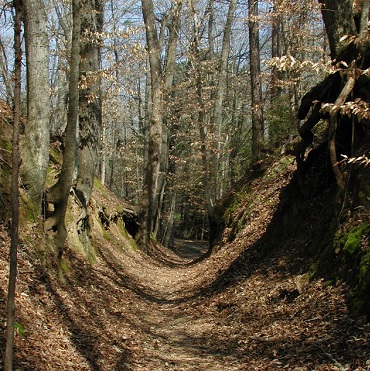
The Old Trace has many sunken areas that were eroded by the footsteps of thousands of travelers.
With an eye toward further westward expansion, President Thomas Jefferson decided to bind Mississippi (and what later would become Alabama) to the rest of the country by transforming a 450-mile forest track called the Natchez Trace into a road for merchants, missionaries and post riders.
Every year when the Ohio, Mississippi and Cumberland rivers rose following the autumn rains, hundreds of keelboats brought horses, corn and whisky from as far away as Pittsburgh. But the only way these flatboat pilots, called Kaintucks, could get home was to book expensive passage on a schooner to New York from New Orleans. A better road would reduce the time and money it took to return home.
The Old Trace zigzagged through canebrakes, skirted Cypress-filled swamps and crossed two large rivers before rising 2,000 feet into the heart of the Eastern Hardwood Forest, an expanse of virgin timber so dense that, according to local lore, a squirrel could travel from Maine to Texas without touching the ground. Homeward-bound Kaintucks needed three to four weeks to walk between the two towns. Post riders took 15 days to carry mail from Natchez to Nashville.
Following the purchase of Louisiana in 1803, traffic on the Trace increased exponentially. By 1810, more than 10,000 Kaintucks each year rode or hiked northward up the Trace. At night they slept in one of 50 roadside “stands” with names like Buzzard Roost and Sheboss Place that advertised “wilderness entertainment” with “great provender and provisions.”
During the first three decades of the 19th century, the Natchez Trace was the Southwest’s most traveled road. Andrew Jackson used it on his victorious return from the Battle of New Orleans. So did former vice president Aaron Burr. The empty brick buildings of Jefferson College in Washington, Miss., where Jackson was feted and Burr acquitted for plotting sedition testify to the former importance of the wilderness highway.
Other sites on the parkway bear mute witness to what America has lost. In 1810, when Alexander Wilson arrived at Pigeon Roost Creek at parkway Milepost 204 he saw a flock of passenger pigeons 240 miles long that he estimated contained over two billion birds. “From right to left as far as the eye could reach, the breadth of this vast procession extended,” he noted. “The noise in the woods was so great as to terrify the horses.” Today, the forest of beech trees that provided food for the pigeons are gone, along with the passenger pigeons which became extinct in 1914.
The Natchez Trace Parkway is now a landscaped two-lane highway that parallels the Old Trace. Maintained by the National Park Service, the 444-mile road angles diagonally across Mississippi and nips through northwestern Alabama before cresting the Tennessee Valley Divide and dropping into Nashville’s Cumberland Valley.
It is America’s most linear national park. It’s also one of the most beautiful.
The trip is perfect for families since about every four miles there’s a pull off to a waterfall, picnic ground, nature trail or historical site. But it’s off the parkway in small southern towns that the region’s history truly comes alive.
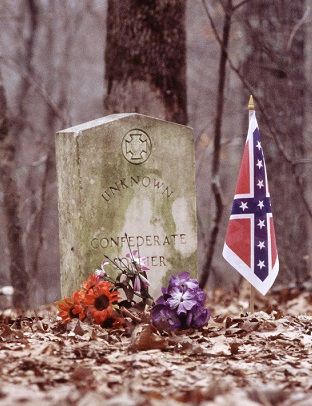
Just north of NPS headquarters at Milepost 269 are 13 graves belonging to unknown Confederate soldiers who may have died at Shiloh.
At the southern end of the parkway is Natchez, a town of 19,000 whose social life and civic identity is rooted in an era when cotton was king. With over 750 antebellum structures and narrow streets designed for carriages the entire downtown is listed on the National Register of Historic Places. Natchez’ biggest industry is tourism, which peaks during the Spring Pilgrimage event when dozens of mansions are open to the public.
Natchez is perhaps the only city in America where it’s possible to buy a piece of 19th century America at a reasonable price. Several old homes are always up for sale thanks in part to the Historic Natchez Foundation, which buys and renovates distressed properties for eventual resale. “We’re the humane society for old buildings,” explains Ronald Miller, an architectural historian who serves as the foundation’s executive director. “We look for endangered, abandoned or neglected buildings and try to give them loving care.”
Further north on the Trace inside Tennessee at Milepost 386 is the grave of Meriweather Lewis. On the afternoon of October 10, 1809 the hero of the Lewis and Clark expedition pulled into Grinder’s Stand on the Natchez Trace with over $100 in cash. That evening an innkeeper found Lewis shot in the head. His death was declared a suicide, but suspicions arose when the formerly impoverished Grinders moved to western Tennessee with enough money to buy land.
In Vicksburg, it is impossible to escape the memory of the 47-day siege that brought the Gibraltar of the South to its knees. Perhaps that’s because it is impossible to enter the city without passing the federal military park that celebrates the Union Victory. “People who think America has never lost a war don’t realize that many of us have experienced defeat on our own soil,” says Tom Pharr, the 53-year old architect who owns Anchuca, the 1830 Greek Revival mansion that lives on as a centrally-located bed & breakfast. Anchuca was home to Jefferson Davis’ family following the Union army’s looting of their plantation. Davis made his last public speech from Anchuca’s front balcony; an event Pharr commemorates each day by raising the Confederate flag.
For a look at Mississippi today, motorists should pull off the Trace at Kosciusko, a town of 7,000 named for the son of a Polish noble who served under George Washington in the Revolutionary war. Kosciusko’s favorite daughter is Oprah Winfrey, but the biggest celebrity attraction on the Trace is the Elvis Presley Center in Tupelo, which includes a museum, gift shop and memorial chapel where the disembodied voice of Elvis sings gospel songs on a continuous loop.
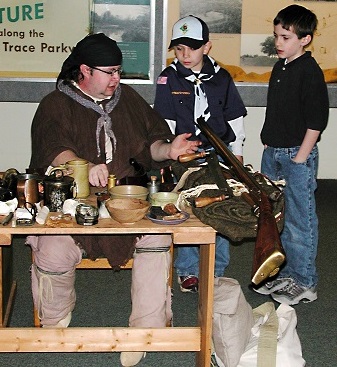
The Tombigbee Pioneers are a group of Mississippi historical reenactors who bring the history of the Natchez Trace to life.
To make sure that people living along the Natchez Trace don’t forget their history, the Tombigbee Pioneers devote around 20 weekends each year giving presentations of early pioneer life to families attending festivals, museums and Living History events. “Our main purpose is to demonstrate pioneer crafts and skills to children and their parents,” says Pat Arinder, an amateur historian and insurance salesman from Amory, Miss. “I’ve spent $1,000 of my own funds on costumes for the children because they like to visualize themselves living two centuries ago,” he says![]()
Tips for the Trace
You should know – The 50 mph speed limit on the two-lane Natchez Trace Parkway is strictly enforced, especially in autumn when bicyclists come for the fall foliage.
Must See — You can visit antebellum mansions in Natchez and Vicksburg year around, but during Spring Pilgrimage women in period costumes lead the guided tours.
Inside Tip – Just west of the parkway 30 miles north of Natchez stand the ghostly ruins of Windsor Plantation. Visit early in the morning or late in the day when wind blowing off the Mississippi River whistles past the charred capitals of the ruin’s 23 Corinthian columns.
For the Gourmet – Natchez’ dry rub barbecue and Tupelo’s catfish are delicious. Also worth a stop is the Tupelo Buffalo Park, a family-oriented zoological park and petting zoo, which sells buffalo steaks.
Historical Highpoint – The bloodiest battle of the Civil War occurred just east of the Trace in Franklin, Tenn. More than 9,000 men were killed or wounded during five hours of hellish hand-to-hand combat. Fought around the Carter House, the most bullet-riddled building in America, the battle broke the back of the Confederacy, which surrendered four months later at Appomattox.
For more information – See the National Park Service or call the Natchez Trace Tourism Compact at (800) 533-0611 for travel itineraries and historical brochures![]()


